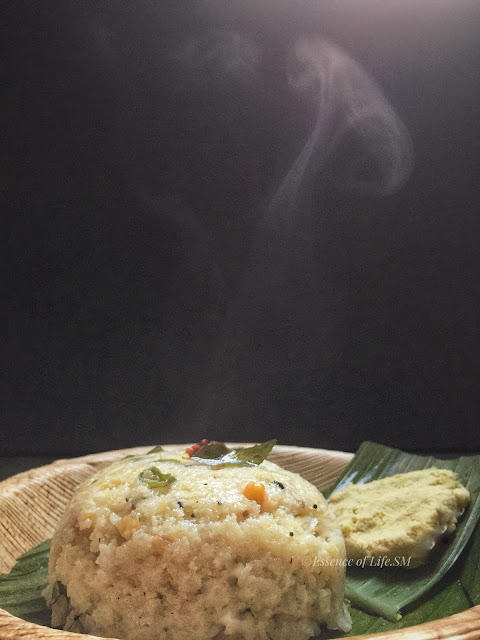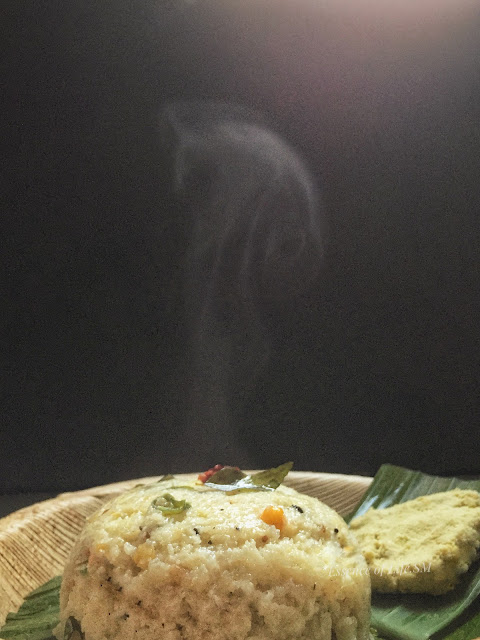ARISI UPMA - RICE UPMA
 |
| ARISI UPMA - RICE UPMA |
Arisi Upma Kozhukattai is one tiffin item I frequent at home. All these days, I had thought my husband wouldn't prefer eating it as Arisi Upma. I couldn't say why, I had assumed it so. To my dismay, I found that he liked the dish when we dined at Mangalambika Coffee House at Kumbakonam during our recent trip to India. We went to Kumbakonam with the sole intention of trying out their popular Kumbakonam Degree Coffee, and we were amazed by the Coffee and the tiffin items. From the long list of dishes we ordered, and we all took turns sharing and eating all the dishes, so that we wouldn't miss out the taste of any. It was a whole family trip and all loved this Arisi Upma along with Kumbakonam Degree Coffee.
So, for the recent reminiscence, Arisi Upma - which is from my long forgotten collection of recipes from my college days. Just what I needed was to adjust the Rice : Water Ratio as perfect as for Arisi Upma. Rice/Arisi Upma is one of the popular tiffin items in a Brahmin household.
This is a simple recipe made with coarsely ground rice which is called
as NOI or KURUNAI ARISI. The only work in terms of this tiffin
item is soaking the raw rice, and then drying it indoor for a few hours
until all the moist is gone, then pulsing it in a dry mixer grinder jar
into a coarse rice powder a.k.a kurunai like texture. Once you have the
rice kurunai(small tit bits), then the job gets easier.
For Arisi Upma, add a bit of Peppercorns, Cumin and Tuvar dhal before grinding it coarsely. This gives out a wonderful flavour to the dish. Then the Rice mixture is cooked along with seasoning until 1/2 cooked and then again it is cooked for about 3-4 whistles in a pressure cooker. This is the main trick which results in a perfectly textured soft Arisi Upma.
Arisi Upma, is an easy and tasty breakfast/dinner dish popular in a Tamil Brahmin household. Some prepare the same adding a bit of extra Dhal(Tuvar/Moong Dhal) to it. As such each household has a unique recipe of their own and this is how I make. Arisi Upma goes well with tangy curries like Puli Kos, Brinjal Gothsu, Puli Kuzhambu or simply serve it with your choice of Chutney or Sambar.
For more TIFFIN ITEMS, Click here...
Cuisine : South Indian
Course : Main Course
Difficulty : Medium
Serves : 3-4
Yields : 15 Nos.
Author : SM
Soaking Time - 15-20 Minutes
Drying Time - 20 - 30 Minutes
Cooking Time - 20 - 30 Minutes
For more SOUTH INDIAN BREAKFAST RECIPES, Click here...
HOW TO MAKE RICE / ARISI UPMA

ARISI UPMA - RICE UPMA

INGREDIENTS:
For Grinding:
Raw Rice - 1 CupCumin Seeds - 1 Teaspoon
Peppercorns - 3/4 Teaspoon
Tuvar Dhal - 11/2 Teaspoon
For Arisi Upma:
Gingelly Oil - 2 TablespoonMustard Seeds - 1 Teaspoon
Black Gram Dhal - 1 Teaspoon
Bengal Gram Dhal - 1 Teaspoon
Peppercorns - 3/4 Teaspoon
Asafoetida Powder - 1/2 Teaspoon
Dry Red Chillies - 2 -3 No's
Green Chillies - 1 No
Curry Leaves - a Sprig
Coconut - 1 Cup
Salt - To taste
Water - 23/4 Cup
Ghee - 2 Teaspoon
To make Noi Arisi:
- Soak the raw rice for 15 mins in water.
- After 15 mins, drain the water and spread the rice in a clean kitchen towel and allow it to dry completely.
- Can dry the Rice indoor under a fan.
- Once the rice is dry, add Cumin Seeds, 3/4 Teaspoon Peppercorns & Tuvar Dhal along with the rice & then grind it into a coarse powder in a dry mixer grinder jar.
- Just pulse it once or twice. It should not be ground into a fine powder.
- Noi Arisi seasoned with spices is ready for making Arisi Upma.
 |
| ARISI UPMA - RICE UPMA |
For Arisi Upma:
- Boil 23/4 Cups of Water and keep it aside.
- Heat oil in a pan, splutter Mustard seeds, Bengal Gram Dhal, Black Gram Dhal, Dry Red Chillies & whole peppercorns.
- Fry them until they turn into golden brown colour on a low flame.
- Add finely chopped Green Chillies, Ginger and Curry Leaves and sauté for a while.
- Sprinkle asafoetida powder and give a quick stir.
- Add grated coconuts and fry for a few seconds on a very low flame.
- Pour the water into the above mix, add salt and mix well.
- Add a Teaspoon of ghee to the water.
- Add the coarsely ground rice mixture gradually into the boiling water, stirring continuously to avoid lumps.
- Lower the flame and cover the pan with a lid.
- Cook the rice, stirring it occasionally.
- Once the mix becomes thick and dry, switch off the flame.
- Then transfer the Arisi Upma into a bowl.
- Place this into a Pressure Cooker.
- Pour a few cups of water into the Pressure Cooker and allow it to boil.
- Place the bowl with Arisi Upma into the pressure cooker and cover it with a lid.
- Then close the Pressure Cooker with the lid and place the vent cap.
- Let it cook on a high flame for 2 whistles.
- Lower the flame and again cook this for 2 whistles.
- Switch off the flame and wait for the pressure to release.
- Once the pressure is released, open the lid of the Pressure cooker and remove the bowl with Arisi Upma from it.
- Pour in a teaspoon or two of Ghee and gently fluff up the Arisi Upma.
- Serve Arisi Upma hot with Brinjal Gothsu, Sambar, Puli Kuzhambu or any preferred Chutney.
NOTES:
- Do not grind the rice into fine powder, it should be ground coarsely like a kurunai. Just a pulse or two in a dry mixer grinder jar would do the job.
- Adding spices and tuvar dhal while grinding the rice gives a wonderful aroma to Arisi Upma.
- Adding Coconut is totally optional.
- Adding some ghee or oil to the boiling water before adding the rice mixture helps to avoid forming lumps. Also, make sure to stir the mixture continuously.
- Cooking on stove top and then transferring it into the pressure and cooking it again yields with a perfectly textured Arisi Upma.
- I have used 23/4 Cups of Water for 1 Cup of Raw Rice.
- The whole cooking process happens in two steps - 1/2 while it's cooked with the tempering and 1/2 of the cooking happens in the pressure cooker.







0 comments